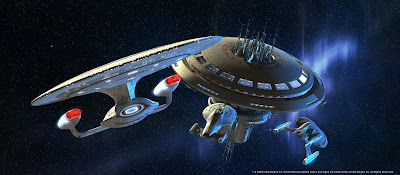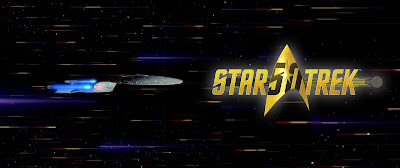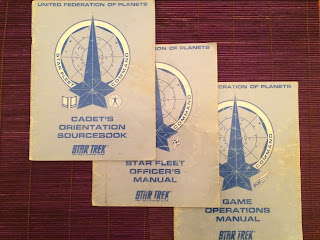 |
| This is how we read in the 24th Century: on a PADD. |
On our last game night, a few friends and I started a new Star Trek campaign, and I’m excited enough about it that I wanted to chat about it here.
Some of us took part in the playtest for the new game–Star Trek Adventures–but this was our first trial of the just-released PDF of the core rulebook. (For more information about the game’s background, read the interview with Modiphius’s Chris Birch that I wrote for Gnome Stew.)
Playtest aside, this is the first Star Trek campaign I’ve kicked off since around 2000, late in the Last Unicorn Games years. For this campaign, things went a bit differently than I had planned. Let me tell you why I think that’s a good thing.
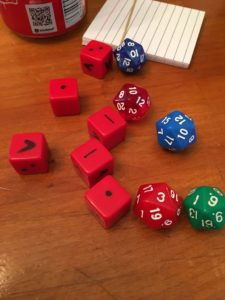 |
The official Challenge Dice haven’t shipped
yet, so we customized some blank dice. |
My Traditional Campaign Setup
One of my favorite things about starting a Star Trek campaign is all the fun decisions I get to make. Things like…
- Which era? Original series? Next Generation? During one of the shows? Before/after the televised episodes?
- Where are we? Alpha Quadrant, like in most TV series? Gamma or Delta Quadrants, like Voyager or parts of DS9? Non-Federation territory? A single planet or starbase?
- Who are the PCs? Standard Starfleet senior officers? Up-and-coming cadets? Academy students? Klingons/Romulans/Cardassians/other non-Federation folk?
- Which ship class? If the setting is a ship (which it usually is), we need to know what kind. A familiar one like the Galaxy-class that’s been extensively featured in a show? A more minor class that hasn’t had the spotlight? Something old and storied, or something new and shiny but untested?
- What’s the ship’s name? After we’ve picked a fun ship (if we’re doing that), we’ve got to name her. Something to honor a part of the real world (like USS Darwin)? A more universal name that would apply across worlds (like USS Discovery)? A name borrowed from a previous series (like USS Reliant-B)?
- Who are the people in your neighborhood? I love filling out the crew roster with non-player characters, the ones who fill the roles not occupied by players.
I usually get input from the players on some of these details, but not all of them. This time, for example, I asked them their preference of era (and the choice was Next Generation), but that’s it. I knew I wanted a ship-based game in the Alpha Quadrant featuring Starfleet senior officers, because I figured that would give us the best chance of using published adventures without a lot of modification.
So, I was just about to start picking out what ship I wanted to set the campaign on when a glance through the new rulebook changed my mind.
Collaborative Campaign Setup: The Ship
One of the things that the Starships chapter in the Star Trek Adventures rulebook covers is a ship’s “mission profile,” a way to specialize any ship class by adding points to this or that system in a pre-set way depending on its assignment. Here’s the bit that caught my eye:
“The players choose a single Mission Profile for their starship.”
The players? Then I flipped back earlier in the chapter, at the discussion of ship classes.
“The Players choose a single class for their starship.”
YES. I realized I hadn’t even considered putting the keys to the starship in the players’ hands. This should absolutely be a joint decision, because the players who are Star Trek fans will have favorite ship classes (and some will likely have ships they strongly dislike!), while even the players who aren’t such fans will still feel more of a sense of ownership if they have a say in which beautiful space boat they get to live in.
Time for me to put on my Old GM’s Hat.
Back when I started running games, in the 80s, a GM was expected to do all the work of setting up a campaign. I loved doing it, but also love the fact that more games now are encouraging us to share that work—and that fun—with the players. I just hadn’t had the chance to do that in a Star Trek game yet!
(I’m not even saying that previous Star Trek RPG publishers didn’t address this, just that if they did, I didn’t notice it and carried along with the way I’d always done it.)
So I took the game’s advice and let the players choose and name their ship. They chose the Intrepid-class, the same one used on Star Trek: Voyager.
Collaborative Campaign Setup: The Crew
Although I had decided not to define anything about the players’ ship, I did prepare some notes on a few crew members before the game. My thinking was that I would have an NPC captain prepared in case no players chose that role, and also have one co-worker for each PC to work with during the introductory adventure.
I like having lists of crew members for a Star Trek game. For one thing, when I improvise some action on the ship with a new crew member, it’s less obvious that I’m winging things if I already have a name and species ready to go for Ensign Extra. My other reason for liking these lists is that the players themselves can select an NPC from it whenever they need one. Instead of asking me if there’s a science officer they can summon to the bridge, they can just look under the list of science officers and pick, say, Lieutenant Meeshay.
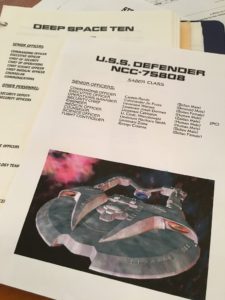 |
| Crew rosters from previous campaigns. |
Star Trek Adventures suggests handling this differently. This game uses the concept of Supporting Characters, which are ones that any player can create on the fly for immediate use. Creating supporting characters involves a simplified version of the game’s character rules (which makes them really improv-friendly), and better yet, players are encouraged to take control of such a character when their main PC would be otherwise away from the action.
And, as with the player decisions being invested in the ship, there’s the hope that they will connect better with crew members they helped create.
As it happens, I DID end up scrapping my NPC plans for the first session and asking the players for ideas. One reason for this is that my three “co-worker” NPCs didn’t feel like a great fit for the PCs after seeing how those characters emerged from the character creation process. (For example, one NPC was a Betazoid and one was a Vulcan—and so were two of the PCs. I wanted the players to feel unique, so I shelved those NPCs.) The other reason…well, we’ll get to the captain shortly.
The He-Man Connection
While the players were creating their characters, one ended up with a Vulcan Chief Medical Officer. When trying to think of a name for the character, this player figured he’d have a nickname along the lines of “Bones.” He went with “Skeletor.” (From a colony planet called Eternia.)
The nickname stuck, a little too well. Because later, when we were brainstorming ideas for the name of the PCs’ ship, I joked that if Skeletor is involved, maybe the ship should be called USS Grayskull. To my surprise, everyone immediately agreed.
It was a good test of my commitment to roll with whatever ship name my players decided on.
The players also immediately rejected my idea for their NPC captain (a Vulcan), eventually deciding that the captain’s name is Adam Randor.
What’s really funny about all this to me is that none of us are He-Man fans.
Final Notes
The players ended up making a Trill command officer, Betazoid/Human science officer, and (as already mentioned) Vulcan doctor. The game’s Lifepath character creation system was fun, and gave each character a home environment (e.g. homeward vs colony), upbringing (e.g. artistic or agricultural), Academy specialty, and a few career events. For example, we learned that our science officer had to take command once in the past to save the day, and that our Vulcan doctor was involved in a transporter accident that cost him a leg.

After making characters, I ran a short adventure I’d written for the purpose of taking the PCs on a test drive. I’ll probably talk more about that in a later post. And I had the opportunity to learn one more lesson that day, after I tried to embrace the game’s philosophy of collaborative creation by asking the players to describe their ship’s transporter chief. The lesson was: don’t expect more creativity right after the players have spent two hours creating their characters.
 |
| “Live long and…” |
|
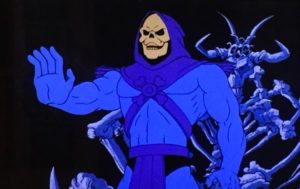 |
| “…rule Eternia!” |
|









